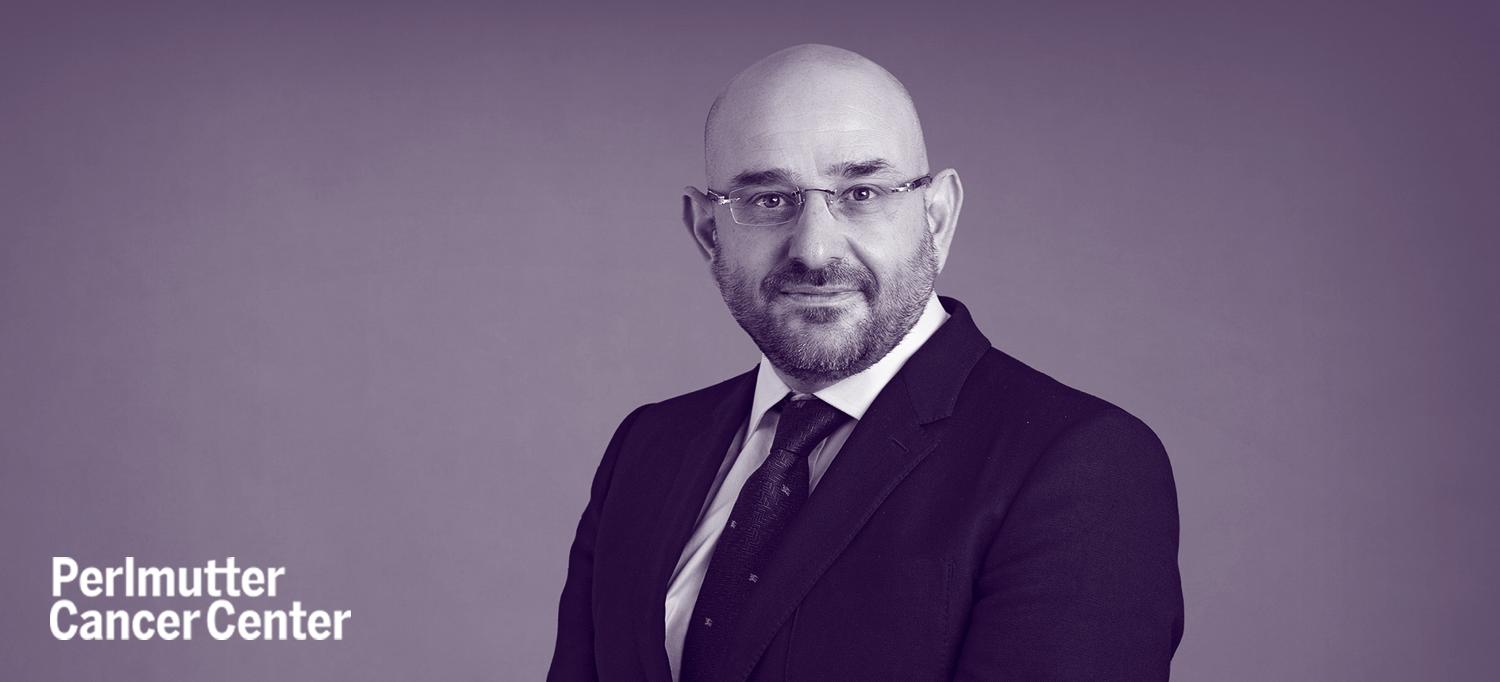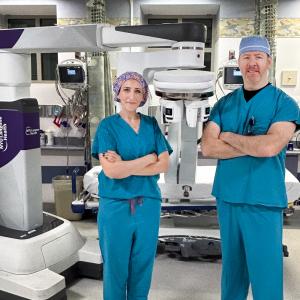
Bashar A. Safar, MD
Photo: NYU Langone Staff
A nationally recognized expert in robotic colorectal surgery and complex gastrointestinal surgical cases, Bashar A. Safar, MD, a clinical professor in the Department of Surgery at NYU Grossman School of Medicine and a member of NYU Langone Health’s Perlmutter Cancer Center, focuses on treating people with colorectal cancer, benign colorectal disease, and other gastrointestinal (GI) conditions. In addition to using minimally invasive robotic-assisted surgery and laparoscopy whenever possible to manage colon and rectal tumors, Dr. Safar also performs transanal minimally invasive surgery (TAMIS) to remove tumors through the rectum. Dr. Safar offers best-in-class medicine and personalized care to people with advanced colorectal cancers.
Below he discusses how his training has informed his approach to treating people with advanced colorectal cancer, his commitment to facilitating access to cancer care, and more.
Before you joined Perlmutter Cancer Center last September, you were a surgeon at Johns Hopkins Medicine and at Washington University in St. Louis. What did you learn at those places, and what does that mean for patients you see here?
At Washington University, I learned how to take care of patients and how to do surgery. As part of a very large academic group, probably the oldest academic group in the country, I honed my skills. Washington University is a fantastic place, and I had five wonderful years there. I also worked at the Veterans Administration hospital in St. Louis, which gave me access to a very challenging group of patients, many of whom had advanced disease. I learned how to do hyperthermic intraperitoneal chemotherapy, or HIPEC, which is a surgery that involves delivering high doses of chemotherapy into the abdomen to treat colorectal cancer that has spread to the peritoneal cavity.
At Johns Hopkins, I was appointed chief of colorectal surgery after I was there for about four years, and I learned another set of skills. As chief, I learned to take care of a group of individuals, grow a strong team, and mentor the players. The volume of cancer cases at Hopkins was quite large, and I learned a great deal about treating people with advanced rectal cancer. In fact, I brought one of my partners from Hopkins—Dr. Chady Atallah, a clinical associate professor of surgery—with me to NYU Langone because we were such a strong team together.
Treating patients with very advanced rectal cancers, which involves removing the bladder and sometimes the spine as well, was a unique experience, and it is a service that we could offer here at Perlmutter Cancer Center that might be limited elsewhere in New York City. A lot of institutions shy away from these cases because they require a multidisciplinary approach, and it is difficult to have all these different disciplines together in one place. At NYU Langone, we have an esteemed Department of Neurosurgery, as well as world-class colleagues in the Department of Urology and other specialties. People with advanced rectal cancers should know that we are very much interested in and capable of taking care of them.
What type of treatments are you offering at Perlmutter Cancer Center?
One treatment approach that will be unique to Perlmutter Cancer Center is combining colorectal cancer surgery with organ transplant.
Not all cancers are created equal, and not all cancers behave equally. Colon cancer tends to be a “well-behaving” type of cancer, and when the biology is favorable, colon cancer lends itself to a variety of approaches.
However, historically, if colon cancer had spread to another organ, the patient would be given chemotherapy and told to write their will and settle their affairs. For decades, removing liver metastases has definitely prolonged patient survival and quality of life. That approach has been extended a little bit, and now some studies in Europe have challenged the dogma for cases where there is a lot of liver disease and it cannot be removed safely, because some liver needs to be left behind for the patient to survive. In those cases, liver transplant might be a way to significantly improve survival.
We are definitely going to offer that here. Unlike some cancer centers, we have access to NYU Langone’s full-care hospital system. One thing that gives us a huge edge is that NYU Langone has a transplant team that leads the city in outcomes and in volume. And they are very keen to collaborate. I have been collaborating and discussing how to offer unique protocols with Dr. Karim J. Halazun, who is a professor of surgery, surgical director of the Liver Care and Transplant Program, and section chief for hepatobiliary surgery in the Division of Hepatobiliary and Pancreatic Surgery at Perlmutter Cancer Center.
This transplant approach is a bit controversial for a few reasons. Where is the organ going to come from? Are these patients going to take some organs from people who need them more? Can you give immunosuppressants to a patient with cancer? I don’t know if we 100 percent understand the answers, but we have enough data to know that it is a viable alternative for those patients. We are enrolling patients with colorectal cancer metastases and a liver transplant protocol coming soon. For the most part, we will be using living donors—someone who is a relative or a friend—to donate a portion of their liver.
From a surgical standpoint, the latest and greatest in my world is robotic surgery, with a focus on minimally invasive techniques aimed at preserving function. We have access to very cutting-edge technology here at NYU Langone as well as the expertise to employ this technology. I believe that we are well positioned to be very competitive in this marketplace.
At Johns Hopkins, you were a proponent of the “5×5 protocol” for treating advanced rectal cancer. What is that and how does it benefit patients?
The 5×5 protocol is another technique that I learned at Washington University. It entails delivering 5 grays of radiation to patients for 5 days, for a total of 25 grays. This is usually followed by full-dose chemotherapy after the radiation has ended. This differs from the typical radiation course, which usually lasts five weeks. The 5×5 protocol allows patients to receive much more effective chemotherapy before surgery.
The idea is to deliver the chemotherapy as soon as possible to patients with the hope that with earlier delivery of chemo, we control distant disease, or disease spread, better. And by controlling distant disease more, we improve survival. The idea behind this is theoretical, but many cancer centers are accepting this theory and providing something called total neoadjuvant therapy, in which patients receive all the chemotherapy and radiation up front.
The disadvantage of doing the traditional five weeks of radiation therapy for the advanced cancers is it delays chemotherapy for six weeks at least. The five-day radiation protocol enables patients to begin chemotherapy the following week, which is significant for people who have advanced disease or in cases in which we want to shrink tumors as soon as possible. I think the 5×5 protocol offers a lot of advantages.
I am passionate about making access to care easy for people with cancer. I don’t want someone coming to see me for care to think that they are going to need to be in the city for five weeks for treatment. Now, there are a lot of ways around that because of the growth of Perlmutter Cancer Center and the NYU Langone system in Brooklyn and on Long Island. For someone from Brooklyn or Long Island, radiation treatment could probably be given there. For those who are traveling long distances to seek care here, this could lessen the cost burden of travel and lodging.
I have been in several meetings with radiation oncologists here, and they are very open to it, so the 5×5 protocol might become an option at Perlmutter Cancer Center. I’m a surgeon and not a radiation oncologist, but I am very much involved with the treatment of this disease, and I would like to see this offered here.
What should people expect when they come to see you for care?
That’s a great question, because I am new to New York, and I am learning myself what medical care in New York is like and what different centers offer. What I have discovered is that NYU Langone has renewed and updated all of its facilities. Perlmutter Cancer Center is located in a wonderful space on 38th Street in Manhattan. The waiting area is comfortable, spacious, and very welcoming. People will feel at ease and comfortable. They will get to meet me and spend as much time as we need together talking about their concerns and anything else we need to talk about. Anyone who is coming to see me can be assured that they will have personalized attention from me—and not a fellow or a resident—geared toward them and their questions.
One thing that is unique about Perlmutter Cancer Center is that the medical oncologists are down the hallway from me if I need to have a quick discussion with them and come up with a plan. There’s no need for the patient to leave and come back. I also think they are going to get the best surgery available. For all these reasons, I believe we will provide as competitive care in New York City as possible.
NYU Langone very much prides itself of being a number one hospital in quality in New York City. And that resonates with me. That is what made me move to this institution. Quality care is something that I would love to provide, and I believe that I do provide. The secret sauce to a lot of things in life is the right institution and the right people. And I feel Perlmutter Cancer Center is the right institution, and I think I have the right people on my team. I feel like we’re set to go.

